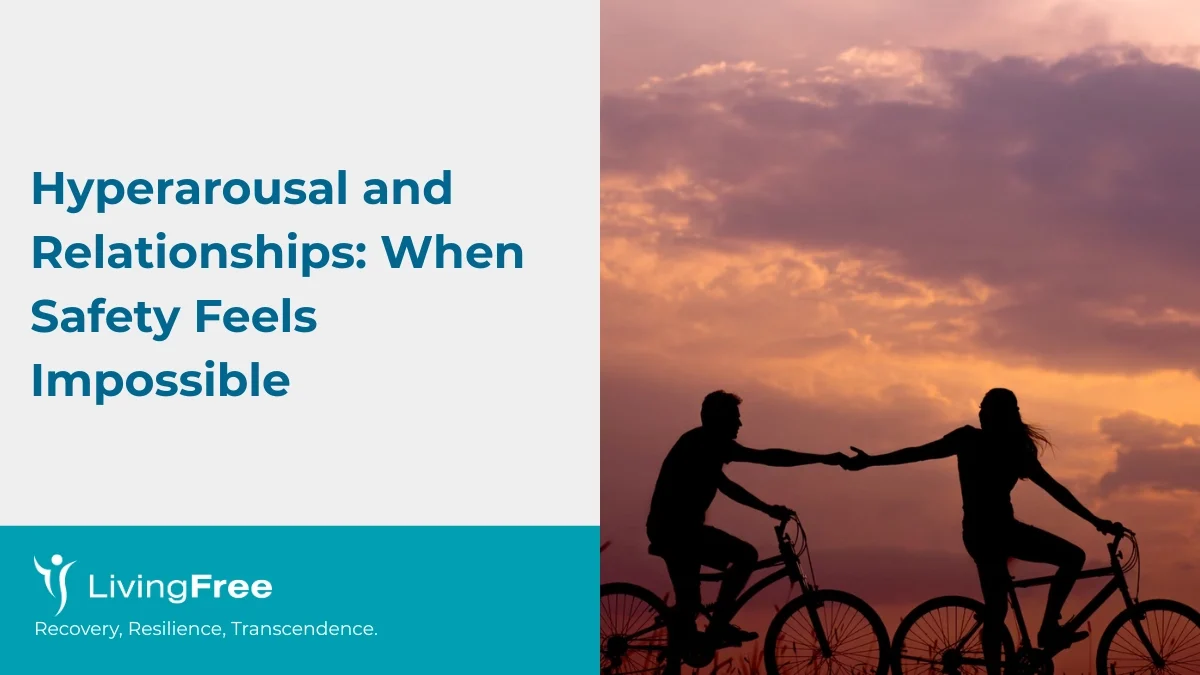Hyperarousal can make relationships feel unsafe and overwhelming. Learn how trauma, nervous system dysregulation, and hypervigilance affect connection and trust.
What Is Relationship Hyperarousal
Hyperarousal is a state where the nervous system stays alert even in safe situations. In relationships, this can make ordinary moments feel tense, confusing, or threatening.
People often describe feeling on edge around their loved ones.
Small conflicts trigger a big response.
Calm conversations suddenly feel like danger.
This does not mean the relationship is unsafe. It means the nervous system is struggling to feel safe.
Living Free’s manuals describe this as the self-protection response. When the nervous system detects threat, the body moves into fight, flight, freeze, or appease.
This reaction is automatic and happens before we have time to think.
Hyperarousal in relationships is not a personality issue. It is a nervous system pattern shaped by trauma, chronic stress, or past relational wounds.
Why Hyperarousal Makes Relationships Feel Unsafe
Human connection requires a sense of safety. The nervous system needs to feel grounded, steady, and open.
Hyperarousal interrupts this process.
According to the polyvagal theory, the body constantly scans for cues of safety or danger. This scanning happens below conscious awareness.
When the system is dysregulated, even neutral cues may be interpreted as threat.
In relationships, this leads to:
- misreading tone or body language
- feeling overwhelmed during emotional conversations
- difficulty calming down after conflict
- assuming rejection or abandonment
- reacting defensively even when you do not want to
The body is trying to protect you. But in doing so, it blocks connection.
How Hyperarousal Affects Romantic Relationships
Heightened Emotional Reactivity
Small issues feel bigger than they are. Your partner raises a concern and your heart starts racing. A normal disagreement feels like a personal attack.
This is because hyperarousal activates survival mode.
The body responds to relational tension as if it is danger. The logical brain goes offline and the protective brain takes over.
Difficulty Feeling Safe in Closeness
Intimacy requires softness and openness. Hyperarousal creates tension and vigilance.
Some people become distant or numb. Others become overly attentive, afraid of losing the relationship. Some swing between the two.
These reactions often stem from past experiences where closeness was unsafe.
Misreading Others’ Intentions
When the nervous system is activated, the brain focuses on threat signals.
Your partner’s facial expression or tone may be misinterpreted.
Neutral comments can sound critical. A pause can feel like disapproval.
Research from Allan Schore on affect regulation shows that early relational stress teaches the nervous system to stay alert. Adults with trauma often rely on this same pattern, even in healthy relationships.
Fear of Conflict
Many people with hyperarousal avoid conflict entirely.
They would rather withdraw than risk escalation. Others react too quickly, hoping to regain control.
Both patterns come from the same place. The body does not feel safe enough to stay regulated.
How Hyperarousal Affects Family and Social Connections
Feeling Easily Overwhelmed
Crowded rooms, family gatherings, or long conversations may be difficult to tolerate.
Even gentle interactions feel too stimulating when the system is overloaded.
Difficulty Trusting Others
Past relational wounds teach the body to stay guarded.
Trust becomes a challenge because vulnerability feels risky.
Pulling Away or Shutting Down
Avoidance is a common response.
You may withdraw from friendships or stop replying to messages. Not because you do not care, but because your system is flooded.
Becoming Hypervigilant
People with hyperarousal often scan for signs of criticism or danger.
This can lead to overthinking or assuming negative intent from others.
Increased Sensitivity to Tone and Expression
A slight change in someone’s expression can feel threatening. This is the nervous system reading too much into a minor cue.
Trauma teaches the body to pay close attention to subtle signals.
Communication Breakdowns Caused by Hyperarousal
Fight Response
You may become defensive, reactive, or argumentative. Your body senses danger and tries to regain control quickly.
Flight Response
You may need to leave the room or end the conversation. This is the nervous system attempting to escape emotional overload.
Freeze Response
You may feel numb, disconnected, or unable to speak.
It feels like shutting down from the inside.
Appease Response
You may try to keep everyone calm by agreeing or apologizing too quickly.
This is a protective strategy to prevent conflict.
Living Free’s manual describes these as adaptive survival responses. They helped you survive past situations.
But in current relationships, they create confusion and distance.
The Neurobiology of Why Relationships Trigger Hyperarousal
Relationships activate the same brain circuits involved in attachment and threat detection.
The amygdala becomes overactive in trauma survivors, scanning for danger even when there is none.
The prefrontal cortex, which helps regulate emotions, becomes less effective during hyperarousal.
According to Bessel van der Kolk, trauma disconnects the brain’s fear circuitry from its reasoning capacity. In relationships, this creates a cycle where the body reacts faster than the mind can interpret.
The polyvagal theory shows that safety is communicated through facial expressions, voice tone, and posture.
When someone is hyperaroused, these cues are harder to notice. Instead, the body defaults to defensive mode.
When Two Nervous Systems Misread Each Other
Relationships are a continuous exchange of nervous system signals.
Hyperarousal disrupts this exchange.
You may intend to communicate calmly, but your partner perceives tension.
Your partner may speak softly, but your system interprets it as criticism.
Misattunement grows when both people feel misunderstood.
This can create repetitive conflict patterns that feel impossible to break.
Treatment, Understanding, and Support
Learn to Identify Early Activation
Noticing activation early helps prevent escalation.
Look for signs such as:
- tight chest
- faster heartbeat
- feeling hot or restless
- difficulty hearing or staying present
- urge to withdraw or defend
This awareness increases your ability to pause.
Regulate Before Communicating
Living Free’s manuals emphasize that regulation must happen before communication. You cannot problem-solve while your body is in survival mode.
Try grounding, slow breathing, or a short break. Communicate that you will return to the conversation when steady.
Build a Sense of Internal Safety
Hyperarousal decreases when the nervous system learns that it no longer needs to protect you from past threats.
Therapies such as Somatic Experiencing, EMDR, and polyvagal-informed work help reset these patterns.
Communicate Your Patterns Gently
Saying something like,
“I get overwhelmed quickly because my body reacts fast. I may need a moment to regulate,” can help partners understand your responses.
Create Predictable Routines
Predictability supports safety.
Clear boundaries, regular check-ins, and consistent behavior help calm the system.
Seek Support When Patterns Persist
If relational hyperarousal affects daily functioning, a trauma-informed therapist can help.
Support is not a sign of weakness. It is a step toward safety and connection.
Related Reading
- Chronic Hyperarousal: When Stress Becomes a Way of Life
- Are You Experiencing Hyperarousal?
- What Causes Hyperarousal? Understanding the Body’s Alarm System
- Re-Experiencing, Emotional Numbing, and Hyperarousal in PTSD
- Psychological Trauma: Understanding the Mind-Body Connection
- Avoidance in PTSD
- Memory Loss in PTSD
- Diagnosis and Treatment of Psychological Trauma
- Why Eliminating Triggers Does Not Work in Trauma Recovery


